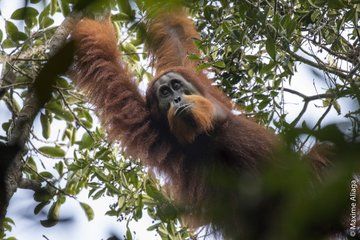New Orangutan Species Is World's Most Endangered Great Ape
Jeanna Bryner, Live Science Managing Editor | November 3, 2017
An isolated group of orangutans hiding out in a forest in Sumatra is now considered an entirely new species and the world's most endangered great ape, researchers say.
Until now, scientists had long recognized six species of living great apes (not including humans): Sumatran orangutans, Bornean orangutans, eastern gorillas, western gorillas, chimpanzees and bonobos. So, to describe a new great-ape species is rare, the researchers said. Fewer than 800 individuals of the newfound species, called Pongo tapanuliensis, survive in the Batang Toru forest.
"It isn't an everyday event that we find a new species of great ape, so indeed the discovery is very exciting," senior study author Michael Krutzen, a professor of evolutionary anthropology and genomics in the Department of Anthropology at the University of Zurich in Switzerland, said in a statement. [In Photos: Adorable Orangutan Shows Off Knot-Tying Skills]
Scientists didn't even know about this population, which lives south of what was thought to be the southern range of Sumatran orangutans, until 1997. After that, research had suggested this group had behavioral and genetic differences from other orangutan groups. But until now, scientists couldn't say for certain that these differences supported a new species designation, they said.
That changed in November 2013, when an adult male orangutan from Batang Toru died due to wounds sustained by local villagers. That event gave the researchers access to study material, and a careful examination revealed differences in the skull and teeth compared with other orangutans, they said.
The researchers also studied the genomes of 37 orangutans, including P. tapanuliensis, and found that about 3.4 million years ago, the Batang Toru population and Bornean orangutans to the north of Lake Toba, in northern Sumatra, split to become separate species.Then, no more than 700,000 years ago, the Bornean and Sumatran orangutans diverged into separate species, the researchers said.
Their analysis and models describe a scenario in which orangutans from mainland Asia first entered a region called Sundaland, in southeastern Asia south of what is now Lake Toba. The lake formed in the caldera of the supervolcano Mount Toba, which was responsible for the largest eruption on Earth in the past 2.5 million years. Then, this ancestral population — of which P. tapanuliensis is a direct descendant — would have subsequently moved into what is now Borneo, Java and northern Sumatra.
"The Batang Toru orangutans appear to be direct descendants of the initial orangutans that had migrated from mainland Asia, and thus constitute the oldest evolutionary line within the genus Pongo," study researcher Alexander Nater, now at the University of Konstanz in Germany, said in the statement. "The Batang Toru population was connected to populations to the north until 10,000 or 20,000 years ago, after which it became isolated."
Currently, the survival of the Batang Toru orangutans is threatened by activities such as illegal road construction, killings during human-orangutan conflicts (over crops) and illegal trade of the animals, the researchers wrote in their paper, which was published online yesterday (Nov. 2) in the journal Current Biology. Perhaps an even more imminent threat, however, is the proposed development of a hydroelectric dam on Sumatra that could impact up to 8 percent of the Batang Toru population, the researchers said.
"To ensure long-term survival of P. tapanuliensis, conservation measures need to be implemented swiftly," they wrote.
Original article on Live Science.

